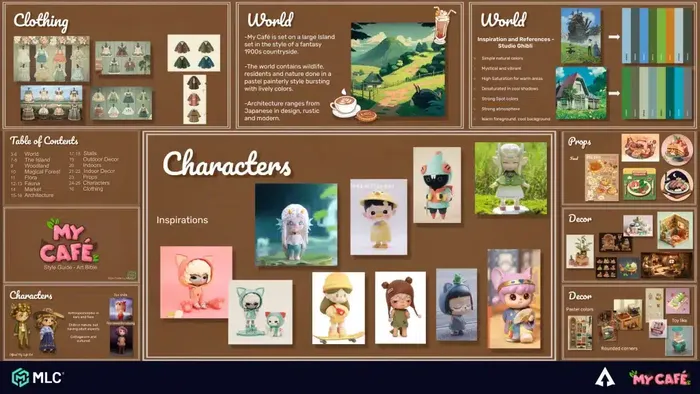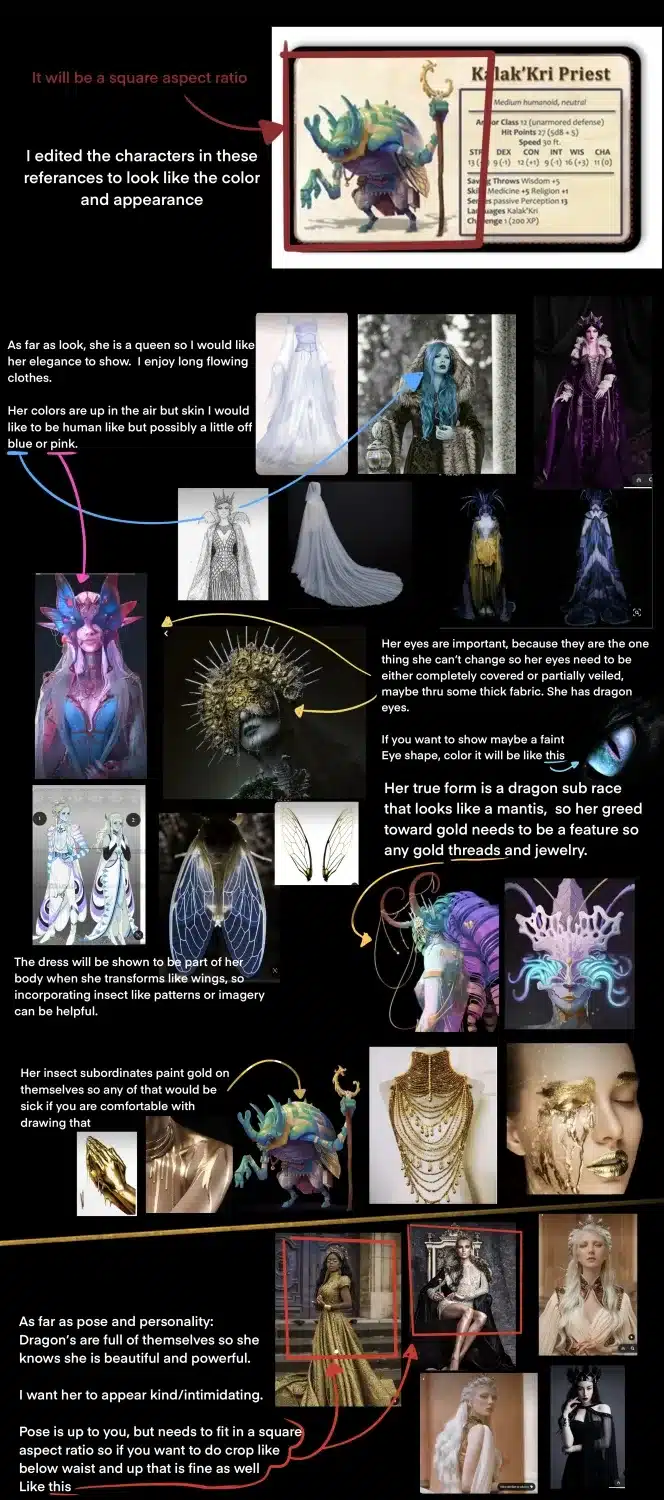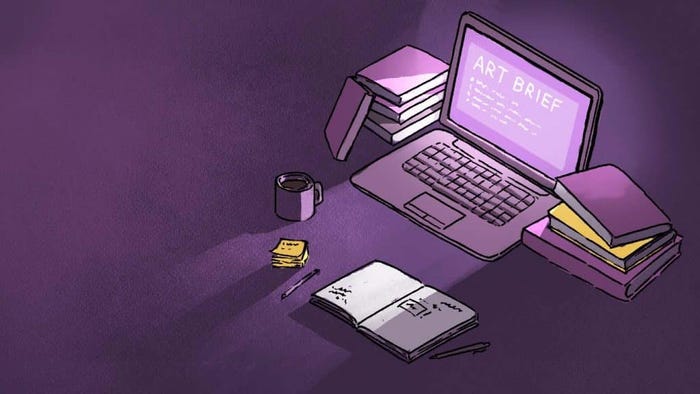Trending
Opinion: How will Project 2025 impact game developers?
The Heritage Foundation's manifesto for the possible next administration could do great harm to many, including large portions of the game development community.

Featured Blog | This community-written post highlights the best of what the game industry has to offer. Read more like it on the Game Developer Blogs or learn how to Submit Your Own Blog Post
In game development, capturing the perfect visual style is paramount.

In game development, capturing the perfect visual style is paramount. It’s what sets your game apart, enthralling players from their very first encounter to their countless return visits.
When it comes to commissioning art for your game, a well-crafted brief becomes your lifeline. It ensures seamless collaboration between you and the artist, sparing you from tedious back-and-forth exchanges.
In our definitive outsourcing guide 2023, we briefly touched upon the crucial aspects of an art brief. But now, we’re taking a deep dive specifically for game development teams like yours, who want to master the art of creating impactful briefs for freelancers or outsourcing studios.
Among other important elements, your art brief is your opportunity to clearly define the scope, style, deadlines, and deliverables specific to the creative part of your game.
In order to develop an exceptional visual style for a game, it is crucial to effectively communicate the game’s narrative, themes, and objectives to the artist. By providing them with a comprehensive overview, you can align their creative vision with yours. This background information will grant them a deeper understanding of the game’s overall context and enable them to incorporate the necessary visual elements that enhance the immersive and captivating gaming experience, consistent with the game’s overarching vision.
To ensure that the artwork truly resonates with the intended audience, it is beneficial to provide your artist with an understanding of the target demographic. This includes describing the persona’s age, gender, interests, and preferences regarding gaming experiences. By doing so, you can ensure that the artwork created is tailored to the specific preferences of the intended audience, thus maximizing its impact.
Furthermore, it is important to provide the artist with information about the game mechanics, controls, and camera positioning. This ensures that the artwork aligns with the game’s technical specifications and effectively highlights the focal points. Rigging artists and animators, in particular, require this information to create artwork that seamlessly integrates with the game’s functionalities and enhances the overall gameplay experience.
Effectively conveying your preferences and vision is crucial when it comes to the visual aspects of your game. It is important to clearly communicate your likes and dislikes regarding visual styles. One valuable resource for artists is a mood board that includes colour palettes, art style references, and desired levels of detail, accompanied by annotations. This provides artists with a visual guide and helps them understand your specific aesthetic preferences.
To provide artists with comprehensive guidance, it is recommended to go beyond the basics and specify the desired fidelity level of the game’s visuals. This includes aspects such as detail level, texture, and lighting. Additionally, information about the game’s world design and environmental factors, such as the setting, atmosphere, and mood, can assist in determining suitable colour schemes, lighting techniques, and overall aesthetics for the creative assets.

Not sure where to start?
If you’re unsure of where to begin, it’s best to break down the task into smaller steps.
✔️ Include a list of do’s and don’ts for the artwork, outlining specific stylistic elements that should or should not be included.
💡Attach an annotated mood board
✏️Napkin doodles and stick figures can be surprisingly helpful in communicating ideas and the desired style.
❌ Show what you don’t want – this can be more helpful than showing what you do want.
📏 Use a scale, such as a 1 to 10 rating system, 1 being cartoony and 10 being realistic, as a useful way to communicate the desired level of realism or stylization, with examples to illustrate the specific points on the scale.
By including these elements, you can greatly assist in the creation of artwork that aligns with your vision and meets your expectations for your game’s visuals.
When providing references for the required work, be as thorough as possible. Use annotations or callouts, like the ones shown below, to highlight specific aspects of the reference that are relevant to your game’s art style.

If you’re referencing a game with a particular lighting style, include annotations on screenshots of the game to highlight the areas that you want to emulate. Similarly, if you’re referencing a movie with a particular colour scheme, you could use a colour picker to extract the exact colours used in the film and include them in your creative brief (Google Chrome’s Web Extension ‘Chroma: Ultimate Eyedropper & Color Picker’ is one of our favourites!), which leads us to talk about mood boards.
Mood boards are an excellent tool for game developers to effectively communicate the desired aesthetic and tone of their game.
These boards consist of various visual elements such as images, textures, and colour palettes that evoke the intended atmosphere. By providing comprehensive mood boards, you can guide the art team in creating artwork that aligns closely with your vision, ensuring a consistent and cohesive overall style for the game. You can refer to the provided mood board example as a guide for the level of detail and content you should aim to include.
These are our top five tips for building a comprehensive mood board:
👁️🗨️ Start with a clear vision: Before you begin creating your mood board, it is essential to have a well-defined idea of the style and aesthetic you want to achieve in your game. This clarity will help you select images that are in line with your overall vision.
🖼️ Select a variety of images: Your mood board should include a diverse range of images. Consider incorporating artwork from other games, films, and books, as well as photographs, textures, and patterns. Aim to choose images that capture the desired mood and tone of the game, along with specific elements you wish to include or exclude.
📚 Consider the context: When selecting images for your mood board, take into account the game’s narrative, gameplay mechanics, and overall aesthetic. Ensure that the chosen images are relevant to the specific elements you want to showcase and align with the overall context of your game.
🔎 Be specific: It is important to be as specific as possible when choosing images for your mood board. Rather than simply selecting images that are visually appealing or interesting, focus on images that effectively convey a particular mood or style you wish to achieve in your game.
💬 Provide explanations: To effectively convey your vision for the game, provide explanations for each image included in your mood board. These explanations can include notes on why you selected the image, how it relates to the overall game vision, and any specific elements you would like to incorporate from that image.
By following these tips and building a comprehensive mood board, you can provide clear guidance to the art team, ensuring they understand and can execute your desired aesthetic and style for the game artwork.
Clearly defined goals and objectives are essential in game development projects as they provide a clear sense of purpose and direction for the team. Additionally, when outsourcing game art, having well-defined goals and objectives becomes even more crucial as they directly impact the quality of the artwork produced.
For instance, consider the following example of a goal and corresponding objective:
Example goal:
“I need to have 3 characters designed within 3 weeks so I can hand them over to our 3D character artist.”
Objective
“Create a character design sheet for each of the 3 characters. The art style should be realistic, and each design sheet should include front, back, and side views of the character. Additionally, close-up shots of the face and any key focus points or accessories should be included. The completion of these design sheets must be achieved within 3 weeks from the start date.”
By clearly articulating goals and objectives in this manner, you provide concise instructions to the artist and set expectations regarding the desired outcome. This helps the artist understand the specific requirements, timelines, and artistic direction necessary to meet the project’s objectives.

It’s understandable to think that providing a comprehensive amount of information may overwhelm the artist, but rest assured, they will actually appreciate it greatly!
Now, let’s focus on creating a deliverable list for your art brief. Depending on the specific requirements of your project, you can expect a variety of deliverables. Here are some common examples:
Primary Game Assets
Some common deliverables can include character designs, environment designs, 3D models, textures, animations and promotional assets.
Secondary Game Assets
In addition to the primary game assets, there are several secondary assets that may be required, such as marketing materials like key art, concept art, and UI design. Other specific visual elements such as cutscene animations can be included in this list.
Marketing materials can include promotional images, videos, and other visual assets that are used to generate interest in the game. Concept art provides a visual representation of the initial ideas and concepts for the game, allowing the client to see what the final product may look like. UI design encompasses all of the visual elements that the player interacts with in the game, including menus, icons, and other graphical elements.
Marketing materials can include promotional images, videos, and other visual assets that generate interest in the game. Concept art allows clients to visualize the game’s direction and potential final look. UI design encompasses all visual elements the player interacts with, including menus, icons, and graphical elements within the game.
To ensure that the final product aligns with your needs and vision for the game, it is crucial to clearly define your expectations and desired deliverables in the art brief. By providing this information, you establish a clear understanding between you and the artist, enabling them to deliver artwork that meets your requirements and brings your game to life.
Don’t forget to include technical specifications that will guide the artists in their work; This includes:
📁 The required file types for the deliverables such as PSD, PNG, or JPEG
🕹️ Any specific in-game limitations that need to be considered.
⏳ Optimization requirements to ensure that the assets are optimized for the target platform and can run smoothly in the game.
🖥️ Software limitations should also be included, such as whether the art team should use specific software like Unreal Engine, Unity, or Maya.
🎮 The version of the game engine that is being used, as this will impact the compatibility of the assets and how they will be integrated into the game.
Providing these technical specifications will help ensure that the artwork produced is optimized for the game and is compatible with the game engine being used.
Including a well-defined timeline and budget estimates in your art brief is essential for effectively managing expectations and facilitating a smooth workflow between the client and the art studio.
Communicating any hard deadlines or milestones upfront is crucial to avoid delays or issues later on. Even if there are no strict deadlines, providing a rough timeline allows the studio to effectively plan and allocate resources for the project.
When outlining the project milestones, clearly specify when you expect each deliverable to be completed. Additionally, provide a rough estimate of the budget available for the project and how it will be allocated across various stages of the process. If there are budget limitations, adjustments to the timeline may be necessary to allow for sufficient time to complete the project.
If you’re uncertain about the budget, it’s acceptable to provide a rough range. This allows the artist to assess if they can deliver the expected work within that budget and provide appropriate recommendations.
We recommend including a contingency budget to account for any potential delays or additional revisions that may arise during the creative process. However, a clear and concise brief should minimize the need for excessive revisions, resulting in better outcomes from the start.
Striking a balance between the timeline, budget, and quality of the final product is essential for a successful project. A reputable studio or artist will assist you in prioritizing the necessary deliverables and making informed decisions that align with your goals and available resources.
Your art brief should also provide details on the distribution process for the artwork. Particularly if you have a preferred delivery method for the artwork. At MLC we use OneDrive, other artists and studios may have their own preferences, so be sure to highlight any specific requirements.
Don’t forget to clarify if there are any restrictions on the use of the artwork, such as whether the studio or freelancer can showcase the work in their portfolio or use it for self-promotion. If there are any restrictions, they should be clearly outlined in the brief to avoid any misunderstandings.
In conclusion, developing a thorough art brief is a crucial step in achieving success when outsourcing game art. This comprehensive document enables you to effectively communicate your vision, requirements, and expectations to the art studio or freelancer, establishing alignment and shared goals right from the beginning.
By following the guidelines outlined in this post and fostering a collaborative relationship, you and the art studio can work together to create a game that not only meets your objectives but also stands out in a competitive market. Through clear communication, attention to detail, and a shared passion for the project, you can bring your vision to life and deliver an engaging and memorable gaming experience.
If you are currently seeking talented artists for your project, get in touch we’d love to hear about what you’re working on and how we can help!
You May Also Like